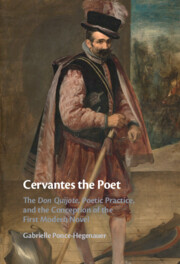 Cervantes the Poet
Cervantes the Poet Published online by Cambridge University Press: 11 May 2023
Chapter 5 reconstructs the site of production for Cervantes’ prosimetric pastoral, the Galatea (1585), and investigates the way in which he disguised himself and members of his own literary milieu as shepherd-poets under pastoral pseudonyms. It employs paratextual sources to reconstruct this milieu. Drawing on early manuscript annotations (ms.2.856, Biblioteca Nacional, Madrid) that identify Cervantes as the “Lauso” of the Galatea and earlier scholarship on the Galatea as roman à clef, this chapter proposes an additional decoding of the work through attention to the use of biographical names (and pseudonyms) for poets associated with the river Tajo in the “Canto de Calíope” (Book VI of the Galatea). With the decline of literary circles in the courts, poetic life migrated from the Alcázar to the barrio de las letras. The established poets of Isabel’s reign – Figueroa, Laínez, Gálvez de Montalvo, Gómez de Tapia, and Cervantes – were joined by younger poets – López Maldonado, Pedro de Padilla, Vargas Manrique, Liñán de Riaza, Juan Rufo Gutiérrez, Lope de Vega, Luis de Góngora – to form a milieu of “urban pastoralists.” The encomiastic poetry that Cervantes wrote indicates a network of authors contemporary to the Galatea, in which the figura of the poet became a literary character.
To save this book to your Kindle, first ensure [email protected] is added to your Approved Personal Document E-mail List under your Personal Document Settings on the Manage Your Content and Devices page of your Amazon account. Then enter the ‘name’ part of your Kindle email address below. Find out more about saving to your Kindle.
Note you can select to save to either the @free.kindle.com or @kindle.com variations. ‘@free.kindle.com’ emails are free but can only be saved to your device when it is connected to wi-fi. ‘@kindle.com’ emails can be delivered even when you are not connected to wi-fi, but note that service fees apply.
Find out more about the Kindle Personal Document Service.
To save content items to your account, please confirm that you agree to abide by our usage policies. If this is the first time you use this feature, you will be asked to authorise Cambridge Core to connect with your account. Find out more about saving content to Dropbox.
To save content items to your account, please confirm that you agree to abide by our usage policies. If this is the first time you use this feature, you will be asked to authorise Cambridge Core to connect with your account. Find out more about saving content to Google Drive.